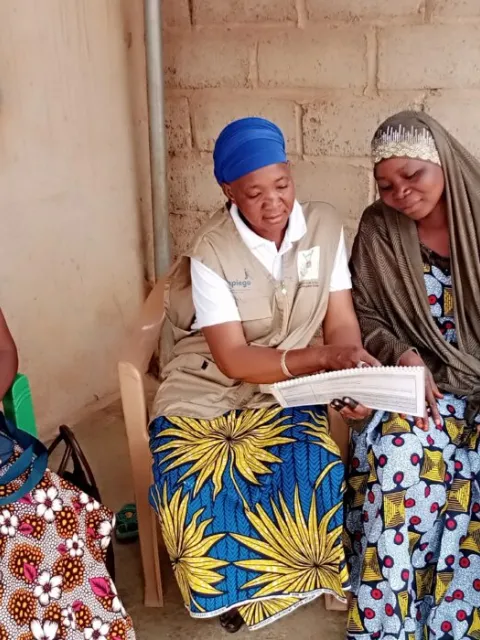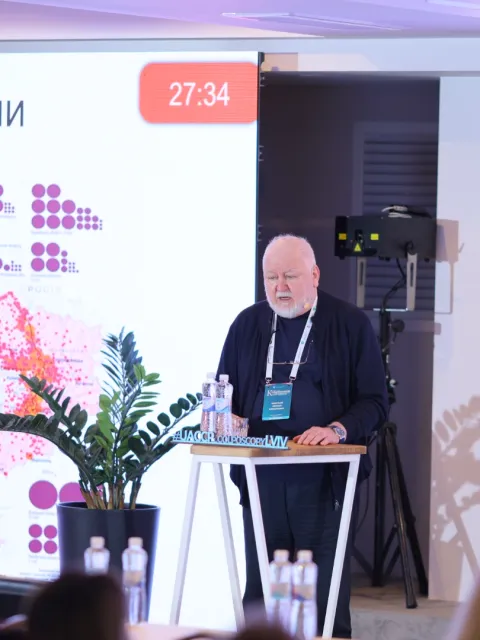Ending the inequity in preventing and treating cervical cancer
UICC and its members have begun working with WHO, government agencies and civil society partners to meet the challenge of implementing the Global Strategy to eliminate cervical cancer in their own countries.

Key Messages
- A woman dies every 2 minutes from cervical cancer, a preventable disease, and 9 out of 10 of these deaths occur in LMICs
- Only USD 10.5bn are required to achieve 2030 cervical cancer elimination targets, services that when sustained would avert 62 million deaths by 2120.
- UICC is a proud partner to the WHO-led Cervical Cancer Elimination Initiative, and is working in new partnerships such as the SUCCESS Project, led by Expertise France and funded by Unitaid, as well teaming up with UICC members to drive regional and national awareness for urgent implementation towards the 2030 targets.
- The Conquering Cancer initiative launches 26th March (see trailer video below).
The global health community has the tools and the technology to dramatically and effectively intervene to prevent women from dying prematurely, often with pain and suffering, from cervical cancer. High-income countries (HICs) are well on their way to achieving what once would have been thought impossible: eliminating a cancer as a public health problem.
While some countries, such as Australia, expect this to happen as early as 2035, the journey is a much longer one, however, for low- and middle-income countries (LMICs), which carry the largest burden of cervical cancer in terms of the number of cases and deaths. A woman dies of the disease every two minutes around the world, but nine in ten of these occur in LMICs. And 60% of women diagnosed with cervical cancer die from the disease in LMIC’s, a percentage up to twice as high as in HICs.
These deaths are avoidable through immunisation against infection with the human papillomavirus (HPV), screening to detect and treat pre-cancerous lesions as well as early diagnosis and prompt management of cancers. Yet, 95% of HPV vaccines distributed between 2006 and 2017 – or some 100 million – were in HICs; today still, only 25% of LMICs have HPV on their national immunisation schedules. Similarly, only 30% of LMICs have adequate treatment services against 90% of HICs.
Disparities in access and outcomes are mirrored within countries. Even in high-income countries, there is much to be done to address inequities based on income, race and ethnicity. In Australia, which is taking a leading role towards eliminating cervical cancer, indigenous populations “experience cervical cancer at the same rates as developing regions of the world,” according to Dr Megan Smith, a senior research fellow at Cancer Council NSW. Cervical cancer is clearly a “disease of poverty” that counts young children amongst its victims, as their survival is subsequently truncated by the premature death of their mothers.
How can national governments, civil society organisations and the global health community mobilise to close this equity gap and provide women everywhere an equal chance of protection from cervical cancer? How to ensure adequate funding to enable lower-resourced countries to achieve the 90:70:90 targets for 2030 outlined in WHO’s Global Strategy?
UICC and cervical cancer elimination
Following the adoption last year of WHO’s Global Strategy, UICC is now urging governments to take a fresh look at actions towards achieving the 90:70:90 targets, implementing measures to ensure access for all girls and women and maintaining a sustained push towards reaching what is considered the elimination threshold of no more than 4 cases of cervical cancer per 100,000 women annually. In particular, UICC is advocating for the early update of state or national cancer control plans and a dedicated cost strategy to cervical cancer elimination.
“UICC is uniquely placed to work with its diverse and global membership to drive national action. We commit to leveraging our convening platforms over the next 10 years to maintain a spotlight on cervical cancer elimination and progress towards achieving the 2030 targets in all countries. We also pledge to harness our convening role across sectors, serving as a facilitator for bringing the skills, expertise and global reach of the private sector to accelerate progress. We will encourage willing parties to build multi-stakeholder partnerships that are very much focused on outcomes with regular reporting or learnings and impact.”
– Ulrika Årehed Kågström, member of the UICC Board of Directors and Secretary General of the Swedish Cancer Society, in her speech at the launch of WHO’s Global Strategy to eliminate cervical cancer, 17 November 2020.
Sharjah Declaration on Cervical Cancer, 2nd edition
End January, Friends of Cancer Patients (FoCP) in the UAE, a UICC Vanguard Partner, organised the 2nd regional forum on cervical cancer entitled “Accelerating Action on HPV and Cervical Cancer”. It was held under the patronage of Her Highness Sheikha Jawaher Bint Mohammed Al Qaisimi, wife of the Rule of Sharjah and International Ambassador of the World Cancer Declaration for UICC.
The forum served as an occasion to reaffirm the commitments of participating governments, academia, international organisations, civil society and advocates to improving access to screenings, vaccines and treatment for HPV and cervical cancer in the Arab region.
The stakeholders also committed to establishing a robust monitoring framework and investment for improved data collection, analysis and utilisation in order to shape evidence-based decision making and identify and address current inequities with regard to HPV vaccine and cervical cancer detection and treatment.
UICC is a consortium partner of the project SUCCESS, Scale Up Cervical Cancer Elimination with Secondary prevention Strategy. This Unitaid-funded project led by Expertise France focuses on the introduction and scale up of HPV testing and thermal ablation services to treat precancers with partners in Guatemala, Philippines, Burkina Faso and Ivory Coast.
UICC has also partnered with the WHO-led Cervical Cancer Elimination Initiative with the following objectives:
- Continue to advocate for a holistic approach to reaching the 4/100.000 women per annum threshold for national elimination, urging governments to make a public commitment to elimination and to girls and women in their populations and calling for the adoption of the 17th November as an annual international elimination day.
- Support WHO with guidelines development and dissemination of guidance materials using the UICC virtual dialogue platform and focus dialogues in partnership with Jhpiego (the Johns Hopkins Program for International Education in Gynecology and Obstetrics).
- Work with UICC members and the Cervical Cancer Action for Elimination network to urge early update of state or national cancer control plans and a dedicated costed strategy to cervical cancer elimination.
UICC supports members in mobilising regional cooperation
This year on World Cancer Day, the European Commission issued a Beating Cancer plan, and UICC joined six other associations including the Association of European Cancer Leagues in issuing a joint statement calling for EU targeted actions aligned with the Beating Cancer plan. The statement emphasises, in particular, the need for evidence-based screening policies; to make screening available in an organised framework and optimise coverage, especially in Central and Eastern Europe, so reach women not responding to an invitation for screening; maximise HPV vaccination coverage; and update EU guidelines for cervical cancer control, integrating elimination services with women-centred approaches and empowering women.
Financing the elimination of cervical cancer in lower resource settings
Upfront investments are required for national programmes to make the shift in emphasis to prevention rather than cure of cervical cancer, which COVID-19 has shown to be so critical. According to a WHO analysis in the Global Strategy (p. 23), USD 10.5bn in total would be sufficient to enable all LMICs to make those upfront investments in human capital, facilities, commodities and equipment to reach the 90:70:90 targets.
However, financing these necessary investments will be a massive challenge in the world’s poorest countries; a report by the Economist Intelligence Unit explores these challenges and provides insights into addressing the funding gap.
“Any funding source for cancer should be evaluated in terms of revenue-generating potential and how it affects the guiding principles of UHC.”
– Filip Meheus, Health economist for the International Agency for Research on Cancer in the EIU report Global action on financing cervical cancer elimination: Funding secondary prevention services in low resource settings.
The report outlines the following set of priorities to engage policy and financing decision-makers: generate local data to inform health financing design and decision making; assess national funding and extent of high-quality services using available WHO costing and modelling tools to develop feasible, stepwise scale-up plans; champion integration at a policy, financing, programme and service level to ensure success and sustainability; and utilise innovative and blended finance solutions to complement domestic funding.
The financial, economic and societal payoff for achieving the 2030 targets is considerable. Every dollar invested through 2050 would be returned more than threefold to the economy due to increases in women’s workforce participation – a return that reaches USD 26 for every dollar invested when incorporating societal benefits.
“What I think is great about the call to elimination is the 90:70:90 targets that UN Member States have set. Achieving them would avert a cumulative number of 300,000 cervical cancer deaths in the next 10 years. This represents a one-third reduction in the rate of premature mortality from cervical cancer in LMICs, contributing to the realisation of the 2030 UN SDGs. The number of lives saved rises to over 14 million by 2070 and over 62 million by 2120 – with associated benefits for the children and families who otherwise be affected.”
– Julie Torode, Director of Special Projects, UICC
Upcoming virtual conferences: Global launch of Conquering Cancer
Conquering Cancer is a global initiative promoting the elimination of cervical cancer elimination. It is being launched on 26th March, with the presentation of the trailer to the 60-minute documentary, Conquering Cancer, scheduled for release in September 2021.
UICC, the American Cancer Society, Cancer Council Australia and Moonshine Agency, along with several other cancer control groups, have worked together on the project, and UICC partner Roche will be presenting the initiative. Registration is free and now open.
- Preventing Cervical Cancer in Australia: Friday 26th March 2021 7:45am - 8:45am AEDT
- Preventing Cervical Cancer in the Indo-Pacific Region: Friday 26 March 2021, 4:15pm - 7:15pm AEDT
Last update
Wednesday 15 March 2023
